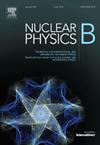Dispersive determination of neutrino mass ordering
IF 2.5
3区 物理与天体物理
Q2 PHYSICS, PARTICLES & FIELDS
引用次数: 0
Abstract
We argue that the mixing phenomenon of a neutral meson formed by a fictitious massive quark will disappear, if the electroweak symmetry of the Standard Model (SM) is restored at a high energy scale. This disappearance is taken as the high-energy input for the dispersion relation, which must be obeyed by the width difference between two meson mass eigenstates. The solution to the dispersion relation at low energy, i.e., in the symmetry broken phase, then connects the Cabibbo-Kobayashi-Maskawa (CKM) matrix elements to the quark masses involved in the box diagrams responsible for meson mixing. It is demonstrated via the analysis of the D meson mixing that the typical d, s and b quark masses demand the CKM matrix elements in agreement with measured values. In particular, the known numerical relation with the s (b) quark mass () can be derived analytically from our solution. Next we apply the same formalism to the mixing of the and states through similar box diagrams with intermediate neutrino channels. It is shown that the neutrino masses in the normal hierarchy (NH), instead of in the inverted hierarchy or quasi-degenerate spectrum, match the observed Pontecorvo-Maki-Nakagawa-Sakata matrix elements. The lepton mixing angles larger than the quark ones are explained by means of the inequality , being the neutrino masses in the NH. At last, the solution for the - mixing specifies the mixing angle , leading to the μ-τ reflection symmetry. Our work suggests that the fermion masses and mixing parameters are constrained dynamically, and the neutrino mass orderings can be discriminated by the internal consistency of the SM.
中微子质量序的色散测定
我们认为,如果在高能量尺度上恢复标准模型(SM)的电弱对称性,则由虚构的大质量夸克形成的中性介子的混合现象将消失。这种消失被当作色散关系的高能输入,色散关系必须服从两个介子质量本征态之间的宽度差。在低能量,即对称破缺相中色散关系的解,然后将Cabibbo-Kobayashi-Maskawa (CKM)矩阵元素与介子混合的盒图中涉及的夸克质量联系起来。通过对D介子混合的分析表明,典型的D、s和b夸克质量要求CKM矩阵元素与测量值一致。特别地,已知的Vus≈ms/mb与s (b)夸克质量ms (mb)的数值关系可以由我们的解解析导出。接下来,我们通过类似的带有中间中微子通道的盒子图,将相同的形式应用于μ−e+和μ+e−态的混合。结果表明,正常层次(NH)中的中微子质量与观测到的Pontecorvo-Maki-Nakagawa-Sakata矩阵元素相匹配,而不是在倒层次或准简并谱中。轻子的混合角大于夸克的混合角可以用不等式m22/m32比ms2/mb2来解释,m2,3是NH中的中微子质量。最后,τ−e+-τ+e−混合的解指定了混合角θ23≈45°,导致μ-τ反射对称。我们的工作表明费米子的质量和混合参数是动态约束的,中微子的质量排序可以通过SM的内部一致性来区分。
本文章由计算机程序翻译,如有差异,请以英文原文为准。
求助全文
约1分钟内获得全文
求助全文
来源期刊

Nuclear Physics B
物理-物理:粒子与场物理
CiteScore
5.50
自引率
7.10%
发文量
302
审稿时长
1 months
期刊介绍:
Nuclear Physics B focuses on the domain of high energy physics, quantum field theory, statistical systems, and mathematical physics, and includes four main sections: high energy physics - phenomenology, high energy physics - theory, high energy physics - experiment, and quantum field theory, statistical systems, and mathematical physics. The emphasis is on original research papers (Frontiers Articles or Full Length Articles), but Review Articles are also welcome.
 求助内容:
求助内容: 应助结果提醒方式:
应助结果提醒方式:


